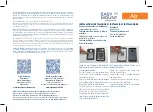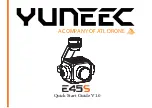
3
SECTION 1 - GENERAL INFORMATION
1.1
CELLYTE 6-12TSG Solar Battery Characteristics
The CELLYTE 6-12TSG Solar battery is a valve-
regulated lead-acid recombinant battery designed
for stationary applications. The 6&12TSG Solar
battery uses Gelled electrolyte technology. This
type of battery has no special ventilation or
handling requirements. Because the electrolyte in
the battery
is
immobilized, the batteries are
considered dry batteries and can be handled and
shipped accordingly.
SECTION 2 - SAFETY INFORMATION
2.1
General Information
Lead acid batteries require care in installation and
maintenance.
Unsafe installation or maintenance
procedures can cause severe injury or death.
Electrical shock or burns, acid burns and fire can
result if proper safety precautions are not followed.
The following precautions apply to all battery
installation and maintenance work.
For more
information, see the following sections.
-
Disconnect all power before attempting to install,
remove or perform maintenance work. When on-
charge float voltages must be measured, be
particularly careful because shorting a battery at
this time can cause not only personal injury, but
severe equipment failure as well.
-
Do not tamper with any parts of the battery
including cover, vents, terminal covers, etc.
-
Keep batteries clean and dry. Use ½ kg of baking
soda in 4 liter’s of water to neutralize any possible
acid. Do not use cleaners or solvents on any part
of the battery.
Do not allow excessive dust to
accumulate on the battery or cabling.
-
Keep battery connectors clean, greased and tight.
A loose connection can reduce battery standby
time and cause battery fires.
2.2
Sulphuric Acid
The CELLYTE 6-12TSG Solar is a lead acid
battery and contains Sulphuric acid in diluted form.
Because the electrolyte is immobilized, in the event
of case rupture, no liquid acid will leak or run from
the battery. However, if the internal components of
the battery are touched or handled, contact with the
acid will result.
CAUTION: Sulphuric acid can cause burns and
serious injury if it comes in contact with your
skin or eyes.
In the event of contact with
Sulphuric acid, flush thoroughly with water and
neutralize any residual acid with baking soda
(1kg in 4 liter’s of water).
Seek medical
attention immediately. Do not handle batteries
that have been dropped or where the container
has been ruptured except while wearing rubber
gloves. Do not try to disassemble a battery.
2.3
Gassing
All lead acid batteries emit some gases during
charging and float operation. Conventional flooded
batteries release all the gases produced to the
environment whereas valve-regulated batteries
re- combine most of the gases internally, releasing
very little to the environment. Compared to a
flooded battery of equal capacity, a CELLYTE 6-
12TSG Solar battery releases a gas volume of
1% or less than the flooded battery. Because of
this characteristic, no special ventilation is
required under normal usage conditions.
Because some gas is released from lead acid
batteries, never charge or use batteries in an
unventilated space or container. This gas consists
of mostly hydrogen gas and can explode if ignited
in a confined area or space. Keep sparks, flame,
or any other ignition source (including smoking
materials) away from batteries.
CAUTION: Hydrogen gas can explode and
cause serious injuries and fire. Do not allow
any flame or ignition source near batteries.
Always
allow
some
ventilation
around
operating batteries; contact SEC if there are
any questions regarding gassing or ventilation.
2.4
Electrical Shock
Batteries store large amounts of electrical energy.
Even a discharged battery can deliver a high short
circuit current. Keep all metallic objects away from
the battery terminals. Multi-cell systems can attain
lethal voltages. Remove all jewelry before working
on batteries.
Cover all tools with vinyl electrical
tape to minimize the possibility of shorting a battery
during installation. Never lay tools or other metallic
objects on batteries.
Do not allow construction
work over batteries to proceed unless the battery is
protected by insulating rubber mats.
CAUTION: Shorting a battery can cause serious
injury, fire or explosion. Do not attempt to work
on a battery unless you are familiar with battery
installation
procedures
and have adequate
safety information and equipment. Read this
manual thoroughly before attempting to install
the battery.
If there are any questions about
safety,
contact
SEC
before
installing
the
batteries.
SAFETY
is
always
the
primary
concern.
SECTION 3 - RECEIPT OF EQUIPMENT
3.1
Delivery Inspection
Immediately upon delivery, inspect the batteries for
damage caused in transit.
Damaged pallets or
packing material or disarrayed batteries could
indicate
rough,
improper
handling
in
transit.
Describe
in
detail
(and
take
photographs
if
necessary) any damage on the delivery receipt
before signature. If any damage is found, contact
the carrier immediately, request an inspection, and
file damage claim.
3.2 Hidden Damage
Within 10 days of receipt, inspect all batteries for
hidden damage. Measure and record open circuit
voltages (OCV's). If any damage is found, request
an inspection by the carrier and file a hidden
damage claim.
Do not delay this step as it may
result in a loss of right of reimbursement for hidden
damages.






























